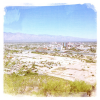Memphis State, TN
The largest university in Memphis, Tennessee, and a leading research institution in the state as well as its surrounding states of Arkansas and Mississippi. The university was founded in 1912 and in 1941 was named Memphis State College, which is how Hillerman refers to it in his 1973 novel Dance Hall of the Dead. However, in 1994 the name was changed, and it is currently known as the University of Memphis.










